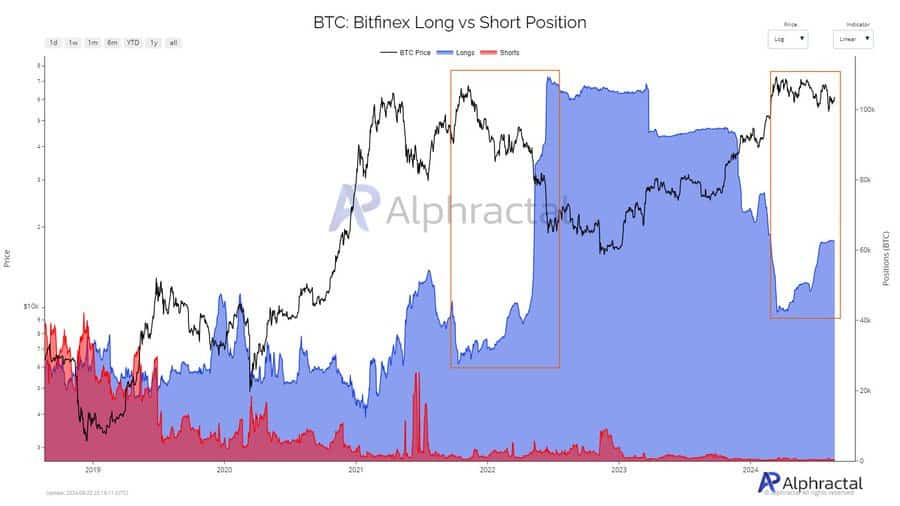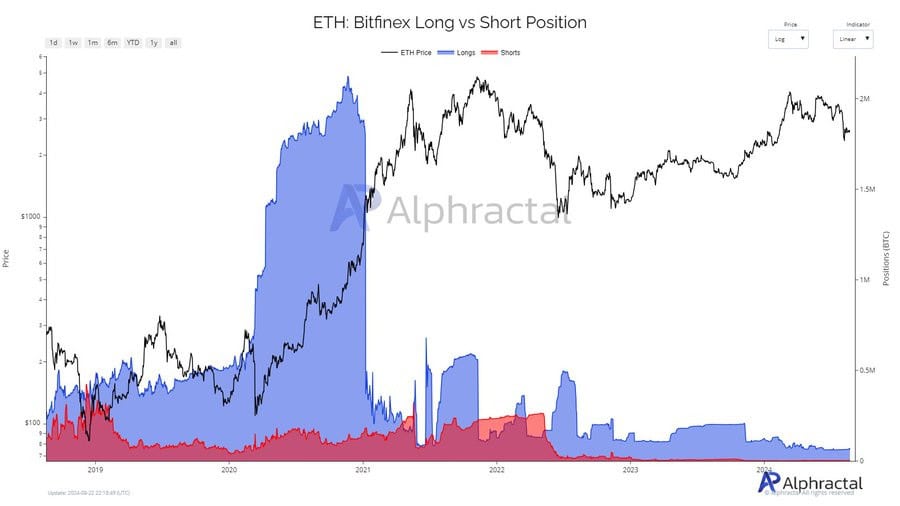Recently, interest in short positions for Bitcoin and Ethereum on Bitfinex has reached all-time lows, according to Alphractal, a professional platform for investment data analysis. This trend marks an enormous shift in market dynamics: historically, a rapid increase in long positions on Bitfinex was usually followed by a market decline.
In the case of Bitcoin, this relationship is very distinct, with an increase in long positions leading normally to a price drop. Bitcoin long positions have been soared to 62,570 BTC, while BTC short positions have remained at a mere 418.5 BTC since March 2024, thus, there are 149 times more longs than there are shorts.

Ethereum represents a new case. Up to 2022, this was the major conflict between long and short positions. Nonetheless, the trend has shifted recently, with short positions decreasing markedly against longs. Remember in 2021 when the total of short positions was higher than long positions? Ethereum was at its cycle peaks at that point.

As of now, 63,860 ETH are in long positions compared to 3,334 ETH in shorts, which is approximately a 19x difference. While most exchanges indicate dominance of long positions, the continuous rise in longs on Bitfinex could suggest potential price declines and forced liquidations of traders. However, a price correction might also present a buying opportunity for market participants.
Bitcoin Demand Growth Declines, Prices Drop
Meanwhile, a CryptoQuant report reveals that Bitcoin’s demand growth has been lackluster and has even turned negative recently. BTC’s apparent demand had significantly slowed since early April, when BTC was trading at around $70,000. The demand fell from a 30-day growth of 496,000 Bitcoin, the highest since January 2021, to a current negative growth of 25,000.
Due to reduced demand, Bitcoin prices have fallen from around $70,000 to $49,000. A recovery in price is dependent on renewed interest. This decline is also seen in the slowing growth of large Bitcoin holders, or “whales,” whose 30-day holdings growth dropped from 6% in February to just 1% now. Historically, whale growth of over 3% has correlated with rising BTC prices.
Furthermore, slowing demand is indicated by reduced purchases of Bitcoin by US spot ETFs. This would, therefore, require increased ETF activities to drive BTC demand higher and consequently move prices up. Despite weak prices, some metrics, such as accumulation by long-term holders and growing market capitalization for stablecoins, suggest that there is underlying strength in cryptocurrency markets.
Related Reading | BNB Investor Turns $1.46M into $4.45M in Just Five Hours Amid Crypto Market Revival







